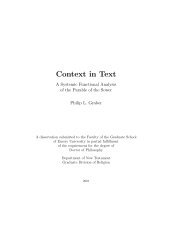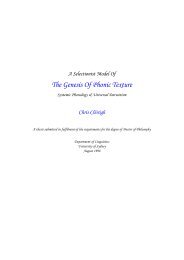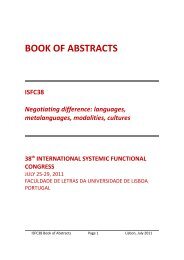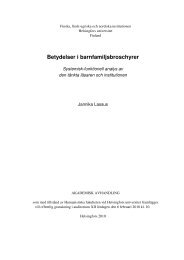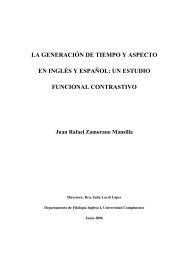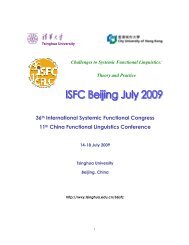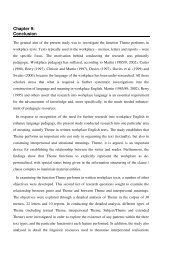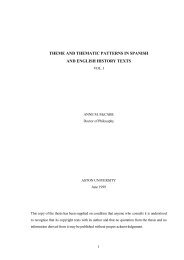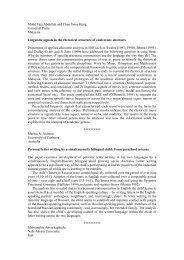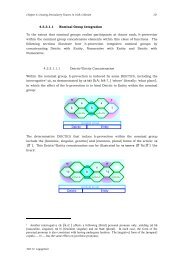the ISFC39 Proceedings - International Systemic-Functional ...
the ISFC39 Proceedings - International Systemic-Functional ...
the ISFC39 Proceedings - International Systemic-Functional ...
You also want an ePaper? Increase the reach of your titles
YUMPU automatically turns print PDFs into web optimized ePapers that Google loves.
to boldly proceed ...account of how such pairings served to align or disalign readers with <strong>the</strong> propositionsadvanced by <strong>the</strong> authorial voice and/or those of o<strong>the</strong>rs introduced into <strong>the</strong> text by attribution,and indeed how such pairings enabled <strong>the</strong> author to establish points of solidarity with readers.Instead, it is intended to open up possibilities for fur<strong>the</strong>r exploration into how successfulprimary students combine resources from across APPRAISAL systems, metafunctions, andeven systems beyond SFL, in <strong>the</strong>ir efforts to persuade o<strong>the</strong>rs. Exciting work remains inanalysing <strong>the</strong> resources used by o<strong>the</strong>r successful students from years 3, 7 and 9, to determinewhe<strong>the</strong>r even younger writers can deploy a similar range of resources, whe<strong>the</strong>r students ateach grade level pair resources differently, and to compare <strong>the</strong>ir strategies in stancing textsand how <strong>the</strong>se position readers. Additional research in this area is needed to discover whe<strong>the</strong>rstudents use <strong>the</strong>se resources by accident or as a result of teaching, and whe<strong>the</strong>r <strong>the</strong> skills <strong>the</strong>ydemonstrate match those outlined in <strong>the</strong> Australian English Curriculum. If it is found thatsuccessful students use linguistic strategies that are not specified in <strong>the</strong> Curriculum at <strong>the</strong>appropriate grade levels, this may be to <strong>the</strong> detriment of less successful students whohaphazardly engage in <strong>the</strong> art of persuasion.ReferencesAristotle. (trans. 2004). The art of rhetoric. London, England: Penguin Books.Australian Curriculum Assessment and Reporting Authority [ACARA] (2011). NAPLAN – Writing test FAQs.Retrieved February 28, 2012, from http://www.nap.edu.au/Bakhtin, M. (1981). Discourse in <strong>the</strong> novel. In M. Holquist (Ed.). The dialogic imagination (pp 259-422).Austin, TX: University of Texas Press.Corbett, E.P.J., & Connors, R.J. (1999). Classical rhetoric for <strong>the</strong> modern student (4 th ed.). New York, NY:Oxford University Press.Halliday, M. A. K. (1977). Text as semantic choice in social context. In T. A. Van Dyck & J. Petrofi (Eds.).Grammars and descriptions. Berlin: de Gruyter.Halliday, M. A. K. (2003). On language and linguistics. London: Continuum.Halliday, M. A. K., & Hasan, R. (1993). Language, context, and text: Aspects of language in a social-semioticperspective. Victoria, Australia: Deakin University Press.Harris, R.A. (2003). Writing with clarity and style: A guide to rhetorical devices for contemporary writers. LosAngeles, CA: Pyrczak Publishing.Joseph, M. (1947). Shakespeare’s use of <strong>the</strong> arts of language. New York, NY: Columbia University Press.Kennedy, G. A. (1999). Classical rhetoric & its Christian and secular traditions from ancient to modern times(2 nd ed.). Chapel Hill, NC: University of North Carolina Press.Martin, J. R. (1992). English text: System and structure. Amsterdam: Benjamins.Martin, J. R., & White, P. R. R. (2005). The language of evaluation: Appraisal in English. New York, NY:Palgrave Macmillan.Matthiessen, C. M. I. M., & Halliday, M. A. K. (1997). <strong>Systemic</strong> functional grammar: A first step into <strong>the</strong><strong>the</strong>ory. Retrieved February 16, 2012, fromhttp://web.mac.com/cmatthie/iWeb/SMMG_resources/Mendoza_2006_Course_Description_files/SFG_FirstStep_1.pdfMiller, D. (2004). “...to meet our common challenge”: ENGAGEMENT strategies of alignment and alienationin current US international discourse. Textus, 14(1), 39-62.Swain, E. (2007). Constructing an effective “voice” in academic discussion writing: An appraisal <strong>the</strong>oryperspective. In, A. McCabe, M. O’Donnell, & R. Whittaker (eds.). Advances in language and education.London: Continuum.Swain, E. (2010). Getting engaged: Dialogistic positioning in novice academic discussion writing. In E. Swain(Ed.). Thresholds and potentialities of systemic functional linguistics: Multilingual, multimodal and o<strong>the</strong>rspecialised discourses (pp. 291-317). Trieste: Edizoni Unversità di Trieste.White, P. R. R. (2001). Appraisal: An overview. Retrieved March 5, 2012, fromhttp://grammatics.com/appraisal/AppraisalGuide/Framed/Appraisal-Overview.htmWhite, P. R. R. (2003). Beyond modality and hedging: A dialogic view of intersubjective stance. Text, 23(2),259-284.74



